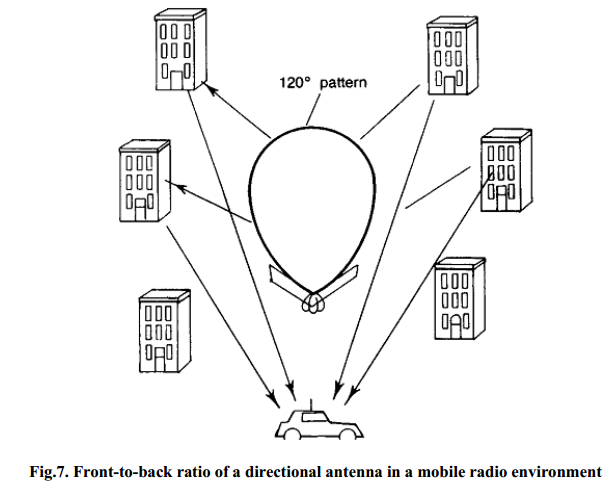Explain in detail the unique situation of the antenna with neat diagram
7. Explain in detail the unique situation of the antenna with neat diagram.
Antenna Pattern in Free Space and in Mobile Environments:
The antenna pattern we normally use is the one measured from an antenna range (open, non urban area) or an antenna dark room. However, when the antenna is placed in a suburban or urban environment and the mobile antenna is lower than the heights of the surroundings, the cell-site antenna pattern as a mobile unit received in a circle equidistant around the cell site is quite different from the free-space antenna pattern. Consider the following facts in the mobile radio environment.
1. The strongest reception still coincides with the strongest signal strength of the directional antenna.
2. The pattern is distorted in an urban or suburban environment.
3. For a 120◦ directional antenna, the back lobe (or front-to-back ratio) is about 10 dB less than the front lobe, regardless of whether a weak sidelobe pattern or no sidelobe pattern is designed in a free-space condition. This condition exists because the strong signal radiates in front, bouncing back from the surroundings so that the energy can be received from the back of the antenna. The energy-reflection mechanism is illustrated in Fig.7.
4. A design specification of the front-to-back ratio of a directional antenna (from the manufacturer’s catalog) is different from the actual front-to-back ratio in the mobile radio environment. Therefore the environment and the antenna beamwidth determine how the antenna will be used in a mobile radio environment. For example, if a 60◦directional antenna is used in a mobile radio environment, the actual front-to-back ratio can vary
 |
| Front-to-back ratio of a directional antenna in a mobile radio environment |
depending on the given environment. If the close-in man-made structures in front of the antenna are highly reflect able to the signal, then the front-to-back ratio of a low-master directional antenna can be as low as 6 dB in some circumstances. In this case, the directional antenna beam width pattern has no correlation between it measured in the free space and it measured in the mobile radio environment. If all the buildings are far away from the directional antenna, then the front-to-back ratio measured in the field will be close to the specified antenna pattern, usually 20 dB.
Regular Check of the Cell-Site Antennas:
Air-pressurised cable is often used in cell-site antennas to prevent moisture from entering the cable and causing excessive attenuation. One method of checking the cell-site antennas is to measure the power delivered to the antenna terminal; however, few systems have this capability. The other method is to measure the VSWR at the bottom of the tower. In this case the loss of reflected power due to the cable under normal conditions should be considered. For a high tower, the VSWR reading may not be accurate. If each cable connector has 1-dB loss due to energy leakage and two midsection 1-dB loss connectors are used in the transmitted systems, the reflected power Pb indicated in the VSWR would be 4 dB less than the real reflected power.
Choosing an Antenna Site:
In antenna site selection we have relied on the point-to-point prediction method, which is applicable primarily for coverage patterns under conditions of light call traffic in the system. Reduction of interference is an important factor in antenna site selection. When a site is chosen on the map, there is a 50 percent chance that the site location cannot be acquired. A written rule states that an antenna location can be found within a quarter of the size of cell R/4. If the site is an 8-mi cell, the antenna can be located within a 2-mi radius. This hypothesis is based on the simulation result that the change in site within a 2-mi radius would not affect the coverage pattern at a distance 8 mi away. If the site is a 2-mi cell, the antenna can be located within a 0.5- mi radius. The quarter-radius rule can be applied only on relatively flat terrain, not in a hilly area. To determine whether this rule can be applied in a general area, one can use the point-to- point prediction method to plot the coverage at different site locations and compare the differences. Usually when the point-to-point prediction method (tool) can be used to design a system, the quarter-radius rule becomes useless.

